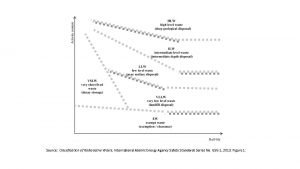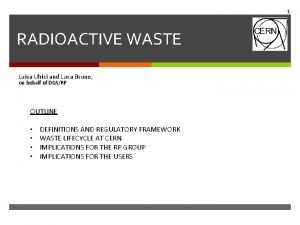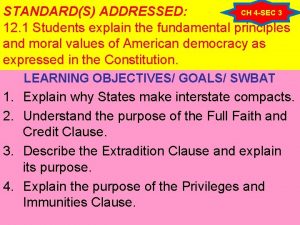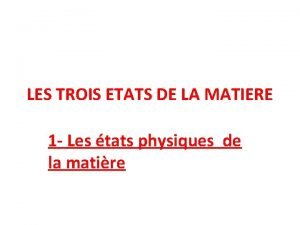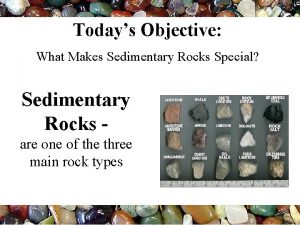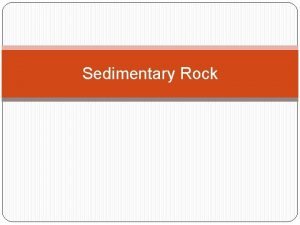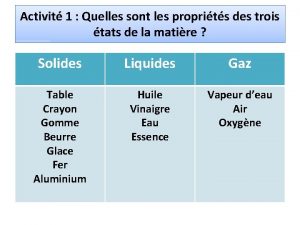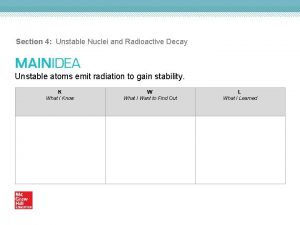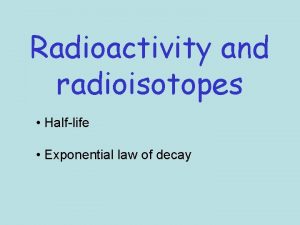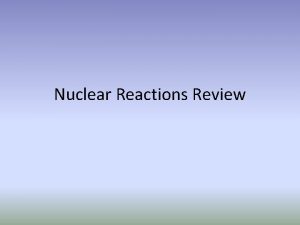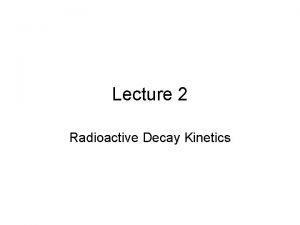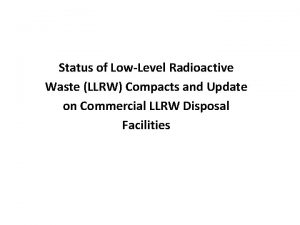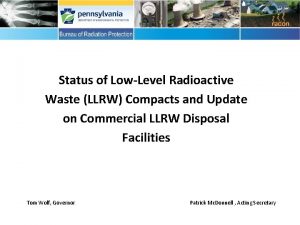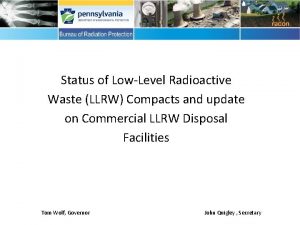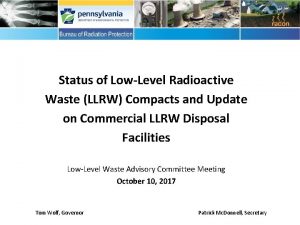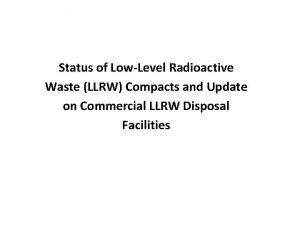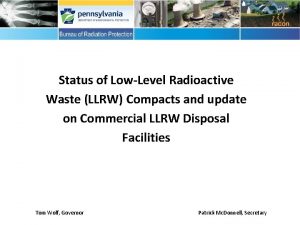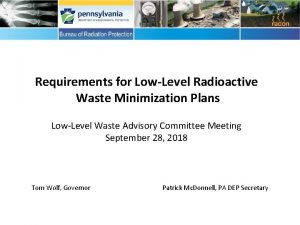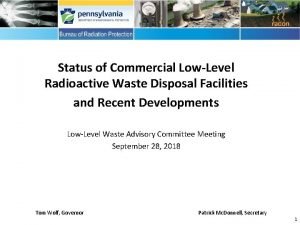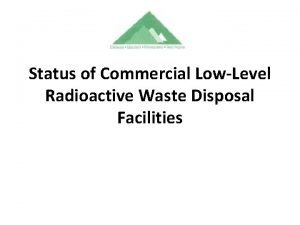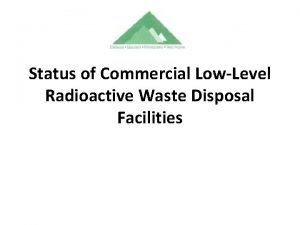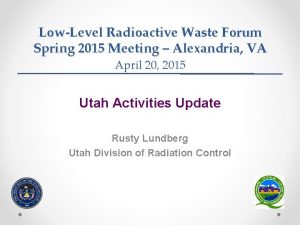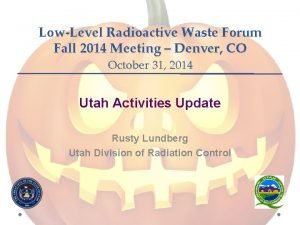Status of LowLevel Radioactive Waste LLRW Compacts and
















- Slides: 16

Status of Low-Level Radioactive Waste (LLRW) Compacts and Update on Commercial LLRW Disposal Facilities

LLRW Classification • NRC regulations (10 CFR Part 61) has specified a waste classification system for LLRW. • There are three (3) classes of LLRW: Class A, Class B and Class C. • The majority of LLRW is Class A waste.

Table 1 Radionuclide C-14. . . . C-14 in activated metal. . . . Ni-59 in activated metal. . . . Nb-94 in activated metal. . . . Tc-99…. . . . I-129. . . . Alpha emitting transuranic nuclides with half-life greater than 5 years…………………. Pu-241. . . . Cm-242. . . . *Units are nanocuries per gram Concentration, curies per cubic meter 80 220 0. 2 3 0. 08 *100 *3, 500 *20, 000

Table 2 Concentration, curies per cubic meter Radionuclide Col. 1 Total of all nuclides with less than 5 year half-life…… H-3. . . . . Co-60. . . . . . . . . . Ni-63 in activated metal. . . Sr-90. . . . . Cs-137. . . . . Col. 2 Col. 3 700 * * 40 * * 700 * * 3. 5 70 700 35 7000 0. 04 150 7000 1 44 4600 *There are no limits established for these radionuclides in class B or C wastes

10 CFR Part 61 – Licensing Requirements for Land Disposal of LLRW • Performance objectives (Subpart C) assure safe disposal of LLRW: Ø Protection of general public Ø Protection of inadvertent intruder Ø Protection of individuals during operations Ø Stability after site closure • Demonstrate performance via technical analysis and waste classification. NOTE: PA equivalent regulations is contained in Title 25, Chapter 236.

Federal and State Legislation • 1980 - Federal LLRW Policy Act • 1985 - Federal LLRW Amendment Act • 1985 - Appalachian States LLRW Act • 1988 - Pennsylvania LLRW Act • 1990 - Pennsylvania LLRW Disposal Regional Facility Act

Federal Legislation Federal Low-Level Radioactive Waste Policy Act Ø States Responsible Ø Compacts Encouraged Ø Exclusion of out-of-Compact Waste

Pennsylvania Responded • Passed Appalachian States LLRW Compact Act in 1985 and formed a compact with Maryland, Delaware and West Virginia. • Is initial host state for facility. • Can legally exclude out-of-compact waste. • Passed Pennsylvania LLRW Disposal Act in 1988. • Passed PA LLRW Regional Facility Act in 1990.

Appalachian States LLRW Compact Commission • Provides for the regional management and disposal of LLRW. • Appalachian States LLRW Compact Act of 1985 established the compact. • Congress consented to the compact in May 1988. • Commission consists of 10 members – PA (4), MD (2), DE (2), WV (2). • Commission became operational in June 1990.

LLRW Disposal Facility Siting Process in PA Statewide Screening ↓ Regional Screening ↓ Local Screening Eliminated 78% of ↓ Land in PA Community Partnering Process ↓ Siting Process Suspended 1991 1993 1994 1996 -1998 December 1998

Reasons for Suspension of PA siting Process 1. Significant reduction in the amount of LLRW due to high cost of disposal. 2. High cost of developing new facilities. 3. Availability of out-of-state disposal facilities.

Appalachian Compact Waste Generation Trend 1986 -98 This data is from the Manifest Information Management System – The Idaho National Engineering and Environmental Laboratory. Volume is in cubic feet

Status of LLRW Compacts

Status of Commercial LLRW Disposal Facilities Ø Barnwell Disposal Facility in South Carolina (Regional Facility) – Accepts Class A, B and C wastes from the Atlantic Compact (CT, NJ, SC) – Closed to generators outside the Atlantic Compact as of July 1, 2008 – Current projected closure date is 2038 Ø Richland Facility in Washington (Regional Facility) – Accepts Class A, B and C wastes from the Northwest and Rocky Mountain Compacts (11 states in 2 compacts) – Accepts radium sources for disposal from other compacts – Current projected closure date is 2056 Ø Energy Solutions Facility in Utah (not a Regional Facility) – Accepts Class A waste from the entire nation except the Northwest and Rocky Mountain Compacts – Approval for disposal of Class A radioactive sealed sources expected – Current projected closure date is 2050

Status of Commercial LLRW Disposal Facilities Ø WCS Disposal Facility in Texas (Regional Facility) ― Two facilities: one license • Compact facility (initially licensed for 2. 3 Mft³ and 3. 9 MCi) • Federal facility for DOE waste (26 Mft³ and 5. 6 MCi) Ø Accepts commercial LLRW (Class A, B and C) and federal LLRW and mixed waste Ø Annual limit on radioactivity of out-of-compact waste is 275, 000 Ci Ø No annual limit on volume of out-of-compact waste Ø Volume expansion from 2. 3 Mft³ to 9 Mft³ granted by TCEQ Ø Disposal of Depleted Uranium (DU) and Greater-Than-Class C (GTCC) waste is being considered Ø Current projected closure date is 2045 TCEQ – Texas Commission on Environmental Quality

WCS Disposal Facility in Texas 1. Access road to 1, 338 -acre fenced site (guard house entrance) 2. On-site rail spur and rail-unloading facility 3. Maintenance building 4. Administration buildings with analytical and radiological laboratories 5. Container Storage Building (CSB) 9. 11 e (2) Byproduct material landfill 10. Federal Waste Disposal Facility (FWF) for LLW and LLMW will expand to the West 11. Compact Waste Disposal Facility (CWF) for LLW will expand to the East 6. Stabilization Building (SB) (West portion) and Mixed Waste Treatment Facility (MWTF) (East portion) 12. Ten-acre storage area for low-specific-activity (LSA) waste 13. Low-level disposal operations administration building 7. Bulk/Bin Storage Units (BSUs)1 -3 (bin storage area [BSA-1] is covered) 14. Rail unloading building for emptying gondola cars 8. RCRA Subtitle C landfill will expand to the East, with closed cells to the West
 Conclusion of radiation pollution
Conclusion of radiation pollution Radioactive nuclear waste
Radioactive nuclear waste Radioactive waste
Radioactive waste Chapter 4 section 3 interstate relations answer key
Chapter 4 section 3 interstate relations answer key Les solides compacts
Les solides compacts Solides compacts et divisés
Solides compacts et divisés La matire
La matire A process that squeezes, or compacts, sediments
A process that squeezes, or compacts, sediments A process that squeezes, or compacts, sediments
A process that squeezes, or compacts, sediments A process that squeezes, or compacts, sediments
A process that squeezes, or compacts, sediments Les solides pulvérisés
Les solides pulvérisés Indian gaming compacts
Indian gaming compacts Unstable nuclei and radioactive decay
Unstable nuclei and radioactive decay Law of radioactive decay
Law of radioactive decay Most unstable radioactive element
Most unstable radioactive element Radioactive materials have unstable
Radioactive materials have unstable Secular equilibrium
Secular equilibrium

